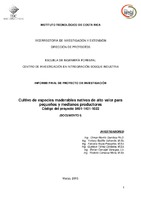| dc.description.abstract | The Project “Cultivation of native timber species of high value to small and medium landholders”, aimed as a superior goal, to initiate a permanent research, development and innovation line with this valuable heritage. The project worked with the species guanacaste (Enterolobium cyclocarpum), cenízaro (Samanea saman), cedro (Cedrela odorata), laurel (Cordia alliodora), amarillón (Terminalia amazonia) y botarrama (Vochysia ferruginea). The main objective was “Improving investment conditions for cultivation of native timber species of high value to small and medium landholders”; however, a two years financial horizon and the “el niño” climatic phenomena, where the main limitations to the establishment of planned field trials in only two effective years. Even though these limitations, the project achieved most of its goals, expected products and targets. The first specific objective proposed the initiation of a breeding program, in which was possible the establishment of provenance/progeny tests with guanacaste (50 families from 6 provenances), cenízaro (38 families from 5 provenances), cedro (32 families from 6 provenances) and laurel (35 families from 4 provenances). With five species (with the exception of botarrama) it were successfully established miniclonal gardens in greenhouse conditions, which generated new important knowledge enough for clonal production. Additionally, it was established a miniclonal garden for almendro (Dipteryx panamensis). A foliage analysis was also performed with all tree species in order to estimate nutrient demand. Second specific objective aimed to generate silvicultural information, however within two years scope it was only possible to establish appropriate field trials. In Liberia, Guanacaste, it were established field trials with guanacaste, cenízaro and cedro, in an area over one hectare each, over a subsoiled soil. With laurel, a new terrain has been prepared (subsoiling, plowing and bedding) and, to be planted in San Carlos, in May 2015. In Santa Clara, San Carlos, spacing field trials were established (7 treatments, from N = 400 until N = 10 000) with guanacaste, cenízaro and cedro. Since cedro had adaptation limitations, it was replaced by amarillón. The third specific objective was based on the construction of a new investment model, which managed to compile an extensive database costs and labor yield information, thanks to the cooperation from more than 10 reforestation companies. The new model was able to systematize variable and fix costs, which included infrastructure, equipment, maintenance and a definition of required human resources for a reforestation project. An EXCEL application was constructed, which allows all possible scenarios projects to be analyzed (small, medium and large landholders). For the tree species almendro, pilón (Hieronyma alchorneoides) and cebo or chancho (Vochysia guatemalensis), it was possible to fit new growth models, with satisfactory results, thanks to the datasets collaboration from forest organizations and companies. Growth models allowed the construction of growth and yield tables for each species, based on general silvicultural guidelines, where thinning keep basal area below 20 m2/ha. As a fourth specific objective it was intended to use AFLP´s in order to characterize each native tree collection, in terms of genetic structure and diversity. However, several limitations occurred due to availability of equipment and chemical reagents. It was possible to optimize in each tree species DNA extraction procedures, DNA purification and processing and, DNA amplification for several combinations. Finally, as a fifth specific objective it was proposed to compile and organize information in order to produce new technical manuals but investment oriented. In terms of progress, all manuals report a 60 to 80% advancement and it is expected to publish them in ITCR Editorial. An event called “Meeting on native tree species for reforestation in Costa Rica” has been organized to be held at the end of June 2015 in Horizontes Forestry Research Station (Liberia, Guanacaste). | es |


